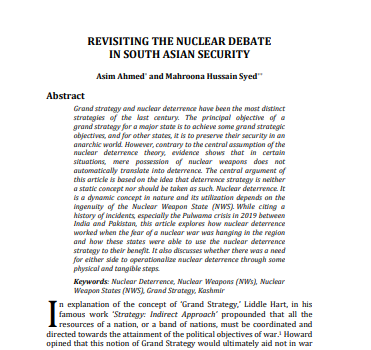REVISITING THE NUCLEAR DEBATE IN SOUTH ASIAN SECURITY
DOI:
https://doi.org/10.54690/jcs.v12i2.262Keywords:
Nuclear Deterrence, Nuclear Weapons (NWs), Nuclear Weapon States (NWS), Grand Strategy, KashmirAbstract
Grand strategy and nuclear deterrence have been the most distinct strategies of the last century. The principal objective of a grand strategy for a major state is to achieve some grand strategic objectives, and for other states, it is to preserve their security in an
anarchic world. However, contrary to the central assumption of the nuclear deterrence theory, evidence shows that in certain situations, mere possession of nuclear weapons does not automatically translate into deterrence. The central argument of this article is based on the idea that deterrence strategy is neither a static concept nor should be taken as such. Nuclear deterrence. It is a dynamic concept in nature and its utilization depends on the
ingenuity of the Nuclear Weapon State (NWS). While citing a history of incidents, especially the Pulwama crisis in 2019 between India and Pakistan, this article explores how nuclear deterrence worked when the fear of a nuclear war was hanging in the region and how these states were able to use the nuclear deterrence strategy to their benefit. It also discusses whether there was a need for either side to operationalize nuclear deterrence through some
physical and tangible steps.

Downloads
Published
How to Cite
Issue
Section
License
Copyright (c) 2024 Journal of Contemporary Studies

This work is licensed under a Creative Commons Attribution-NonCommercial 4.0 International License.
License Terms








